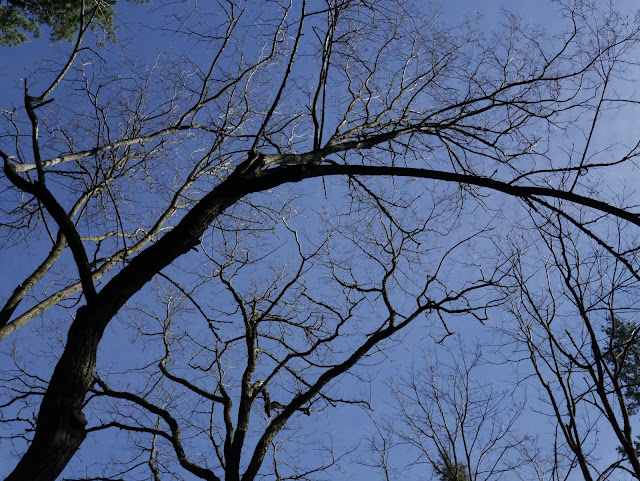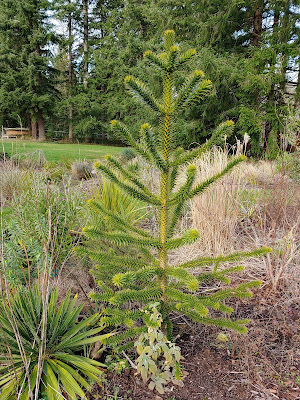The Hoyt, Part II: Oregon myrtles and the winter garden
Today I'm sharing another installment of pictures from my day at the Hoyt Arboretum in Portland, Oregon.
Robinia pseudoacacia is considered a weed tree by many. It has small thorns. It can reseed and send up root suckers and, at least on the East Coast, it has a few pests and diseases (most plants do). It is also prone to breakage, mostly during summer storms, which are typically rare in my area, though we had several last summer. Despite these problems, I love them. The foliage and flowers are beautiful and the former filters cleanly into the grass or plantings underneath in fall. Both are supported by a somewhat wild, upright form with tiered, horizontal branches, creating a light, open canopy. I'm planning to include several in the oak woodland/park I've started planting in a large area of the garden. There are sterile forms that don't reseed, and suckers can be minimized by watering deeply the first few years and encouraging a strong, upright main trunk. I've also read that suckers occur less in clay soils than sandy ones (there do have to be some advantages to clay). I've done so much research in the past few weeks, trying to find an alternative with fewer potential problems that provides the same aesthetics, toughness, drought-tolerance, and airy canopy. I haven't found anything adequate. The winter silhouette against blue skies shows their unique branching structure.
Walking on, one of the hillsides above the magnolia garden is populated by a grove of Umbellularia californica, known by the common names Oregon myrtle or California bay.
In moist sites like this one, they can form large trees. The leaves have many uses in traditional Native American medicine and have been touted as an alternative (though with a stronger, more camphorous flavor) to bay laurel (Laurus nobilis). I have found one source, however, that states toxic compounds were found in the leaves, so probably best to stick to regular bay leaves for cooking.
There is also some evidence that the compounds in the leaf litter produced by Oregon myrtles has an allelopathic affect similar to walnuts. Vegetation is typically sparse under the canopy of an Oregon myrtle. Sword ferns, at least, seem to have no trouble growing under these trees. In harsher conditions, these trees can grow in a prostrate to shrubby form, depending on the severity of the site.
Sassafras albidum 'Molle' has beautiful fissured bark.
This evergreen magnolia was labelled Magnolia foveolata, but the plant I know by that name has a significant coating of reddish gold hairs on the leaves.
Star magnolias are common and sometimes maligned for being so, but they can achieve beautiful forms like this one.
I was pleasantly surprised to stumble across the Winter Garden, even if it isn't very big. Perhaps they'll expand it in the future.
Birches are a classic tree for winter interest. Unfortunately, most of them need regular water in the PNW.
This picture shows almost the entirety of the Winter Garden. It's small, but worth perusing.
Corylus avellana 'Contorta', or Harry Lauder's walking stick. Those twisting branches and dangling yellow catkins form a beautiful display in winter. I still have to figure out where to put the one I got from my friend, Anna. It spent the winter planted temporarily in the Acer griseum bed. It actually doesn't look half bad there, but will eventually grow too large.
Camellia sasanqua 'Showa-No-Sakae'
Not sure what this blue-grey conifer was, but I loved it in combination with the yellow-variegated plant behind it, which I think was an Osmanthus heterophylla 'Goshiki'
Not everyone likes dead plant material in the garden, but I love sculptural pieces of wood like this one.
Erica arborea 'Estrella Gold'. Yes, I photograph this plant way too much. I can't help it. I love it. I need about a dozen more Erica arborea in my garden.
Azara microphylla 'Variegata' is another winter standout, with beautiful variegated foliage.
Someday my recently-planted sarcococca will look like this. The fragrance from this large patch was delightful.
Such cute little flowers.
Harry Lauder's walking stick and variegated azara.
On the other side, a yellow witch-hazel is backlit by the winter sun.
Hamamelis 'Diane' grows a little ways off the other side of the path.
Texture is often overlooked in the garden in favor of color, but it is just as important. Cephalotaxus harringtoniana 'Prostrata' is a standout evergreen in the texture department.
Also known as spreading Japanese plum yew, this is a tough evergreen for the shady garden. Though somewhat drought-tolerant once established, it does need supplemental water in our dry-summer climate. A deep watering once a month in summer should be sufficient, unless it's in an especially dry spot. I love the arching branchlets of long needles held in v-shaped rows.
That's where I'll end this round. In the next installment, we'll visit the oak collection.
Robinia pseudoacacia is considered a weed tree by many. It has small thorns. It can reseed and send up root suckers and, at least on the East Coast, it has a few pests and diseases (most plants do). It is also prone to breakage, mostly during summer storms, which are typically rare in my area, though we had several last summer. Despite these problems, I love them. The foliage and flowers are beautiful and the former filters cleanly into the grass or plantings underneath in fall. Both are supported by a somewhat wild, upright form with tiered, horizontal branches, creating a light, open canopy. I'm planning to include several in the oak woodland/park I've started planting in a large area of the garden. There are sterile forms that don't reseed, and suckers can be minimized by watering deeply the first few years and encouraging a strong, upright main trunk. I've also read that suckers occur less in clay soils than sandy ones (there do have to be some advantages to clay). I've done so much research in the past few weeks, trying to find an alternative with fewer potential problems that provides the same aesthetics, toughness, drought-tolerance, and airy canopy. I haven't found anything adequate. The winter silhouette against blue skies shows their unique branching structure.
Walking on, one of the hillsides above the magnolia garden is populated by a grove of Umbellularia californica, known by the common names Oregon myrtle or California bay.
In moist sites like this one, they can form large trees. The leaves have many uses in traditional Native American medicine and have been touted as an alternative (though with a stronger, more camphorous flavor) to bay laurel (Laurus nobilis). I have found one source, however, that states toxic compounds were found in the leaves, so probably best to stick to regular bay leaves for cooking.
There is also some evidence that the compounds in the leaf litter produced by Oregon myrtles has an allelopathic affect similar to walnuts. Vegetation is typically sparse under the canopy of an Oregon myrtle. Sword ferns, at least, seem to have no trouble growing under these trees. In harsher conditions, these trees can grow in a prostrate to shrubby form, depending on the severity of the site.
Sassafras albidum 'Molle' has beautiful fissured bark.
This evergreen magnolia was labelled Magnolia foveolata, but the plant I know by that name has a significant coating of reddish gold hairs on the leaves.
Star magnolias are common and sometimes maligned for being so, but they can achieve beautiful forms like this one.
I was pleasantly surprised to stumble across the Winter Garden, even if it isn't very big. Perhaps they'll expand it in the future.
Birches are a classic tree for winter interest. Unfortunately, most of them need regular water in the PNW.
This picture shows almost the entirety of the Winter Garden. It's small, but worth perusing.
Corylus avellana 'Contorta', or Harry Lauder's walking stick. Those twisting branches and dangling yellow catkins form a beautiful display in winter. I still have to figure out where to put the one I got from my friend, Anna. It spent the winter planted temporarily in the Acer griseum bed. It actually doesn't look half bad there, but will eventually grow too large.
Camellia sasanqua 'Showa-No-Sakae'
Not sure what this blue-grey conifer was, but I loved it in combination with the yellow-variegated plant behind it, which I think was an Osmanthus heterophylla 'Goshiki'
Not everyone likes dead plant material in the garden, but I love sculptural pieces of wood like this one.
Erica arborea 'Estrella Gold'. Yes, I photograph this plant way too much. I can't help it. I love it. I need about a dozen more Erica arborea in my garden.
Azara microphylla 'Variegata' is another winter standout, with beautiful variegated foliage.
Someday my recently-planted sarcococca will look like this. The fragrance from this large patch was delightful.
Such cute little flowers.
Harry Lauder's walking stick and variegated azara.
On the other side, a yellow witch-hazel is backlit by the winter sun.
Hamamelis 'Diane' grows a little ways off the other side of the path.
Texture is often overlooked in the garden in favor of color, but it is just as important. Cephalotaxus harringtoniana 'Prostrata' is a standout evergreen in the texture department.
Also known as spreading Japanese plum yew, this is a tough evergreen for the shady garden. Though somewhat drought-tolerant once established, it does need supplemental water in our dry-summer climate. A deep watering once a month in summer should be sufficient, unless it's in an especially dry spot. I love the arching branchlets of long needles held in v-shaped rows.
That's where I'll end this round. In the next installment, we'll visit the oak collection.


























The caphalotaxus is gorgeous!
ReplyDeleteIsn't it just?
DeleteI'm quite taken with that Cephalotaxus, which is new to me. The Hoyt continues to amaze and impress.
ReplyDeleteUnfortunately, it would probably need a bit too much water in your garden, at least with your current restrictions.
DeleteI might say "long live winter" but it would get too many blogging buds mad at me. Nice to celebrate it while it's here, though.
ReplyDeleteI don't mind winters like this one, with so much sunshine and warmth. But I am ready for spring.
Delete